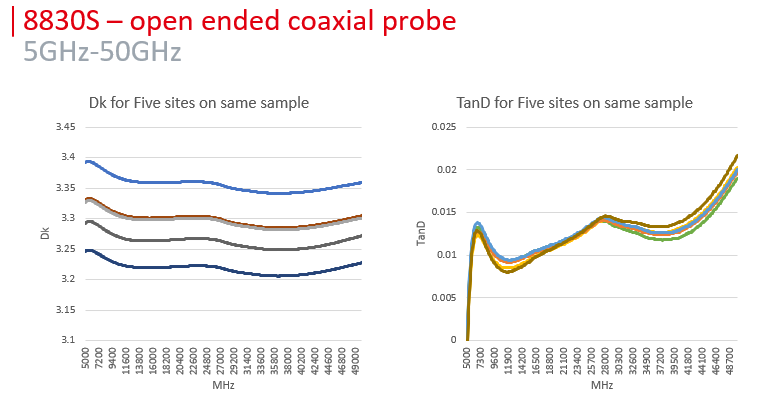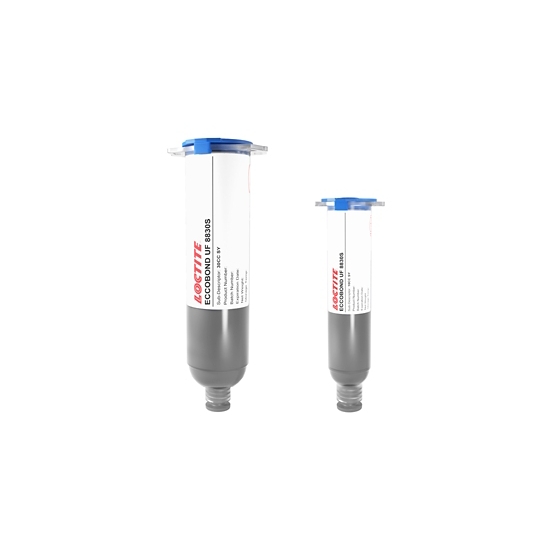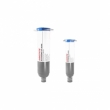LOCTITE ECCOBOND UF8830S
- High purity
- Improved toughness
- Good flow with self filleting
Product Description
LOCTITE® ECCOBOND UF 8830S liquid epoxy Capillary underfill is formulated for tight bump pitch and narrow gap in flip chip BGA applications. It is designed to improve crack/fracture resistance and deliver faster flow. When fully cured, this material forms a rigid, low stress seal that dissipates stress in solder joints and extends thermal cycling performance.
LOCTITE® ECCOBOND UF 8830S achieves MSL L3/L2A and passes all reliability requirements, including automotive applications, without fillet cracks after 4000 cycles(TC -55/150°C). It demonstrates excellent wettability to different substrates, has a wide process window and is also compatible with pressure ovens. Its High Tg with its minimal shift ensures a stable performance for applications with high operating temperatures.
Cure Schedule
- 30 minute ramp from 25°C to 150°C, hold 2hrs at 150°C
Technical Specifications
| General Properties | |||||||
| Pot Life Pot Life Pot life is the amount of time it takes for the viscosity of a material to double (or quadruple for lower viscosity materials) in room temperature after a material is mixed. It is closely related to work life but it is not application dependent, less precise and more of a general indication of how fast a system is going to cure. | 24 hours | ||||||
| Specific Gravity Specific Gravity Specific gravity (SG) is the ratio of the density of a substance to the density of a reference substance; equivalently, it is the ratio of the mass of a substance to the mass of a reference substance for the same given volume. For liquids, the reference substance is almost always water (1), while for gases, it is air (1.18) at room temperature. Specific gravity is unitless. | 1.6 | ||||||
| |||||||
| Physical Properties | |||||||
| Thixotropic index Thixotropic index Thixotropic Index is a ratio of a material s viscosity at two different speeds in Ambient temperature, generally different by a factor of ten. A thixotropic material s viscosity will decrease as agitation or pressure is increased. It indicates the capability of a material to hold its shape. Mayonnaise is a great example of this. It holds its shape very well, but when a shear stress is applied, the material easily spreads. It helps in choosing a material in accordance to the application, dispense method and viscosity of a material. | 0.85 | ||||||
| Viscosity Viscosity Viscosity is a measurement of a fluid’s resistance to flow. Viscosity is commonly measured in centiPoise (cP). One cP is defined as the viscosity of water and all other viscosities are derived from this base. MPa is another common unit with a 1:1 conversion to cP. A product like honey would have a much higher viscosity -around 10,000 cPs- compared to water. As a result, honey would flow much slower out of a tipped glass than water would. The viscosity of a material can be decreased with an increase in temperature in order to better suit an application | 22,120 mPa.s | ||||||
| Mechanical Properties | |||||||
| |||||||
| Thermal Properties | |||||||
| |||||||
| Glass Transition Temperature (Tg) Glass Transition Temperature (Tg) The glass transition temperature for organic adhesives is a temperature region where the polymers change from glassy and brittle to soft and rubbery. Increasing the temperature further continues the softening process as the viscosity drops too. Temperatures between the glass transition temperature and below the decomposition point of the adhesive are the best region for bonding. The glass-transition temperature Tg of a material characterizes the range of temperatures over which this glass transition occurs. | 118 °C | ||||||
Additional Information
What are the processing instructions for UF8830S?
Substrate heating 100 °C

UF 1173 & UF 8830S Dk and Df @ 80GHz

Terms permittivity (Dk) and loss tangent (Df) for UF 8830S - Open ended coaxial probe




